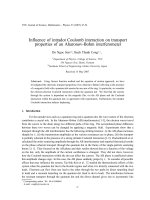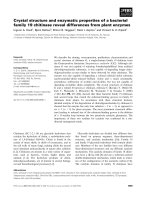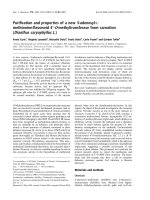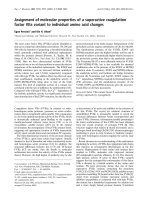- Trang chủ >>
- Khoa Học Tự Nhiên >>
- Vật lý
TRANSPORT PROPERTIES OF a QUASI TWO DIMENSIONAL ELECTRON GAS IN a sisige HETEROSTRUCTURE TEMPERATURE AND MAGNETIC FIELD EFFECTS
Bạn đang xem bản rút gọn của tài liệu. Xem và tải ngay bản đầy đủ của tài liệu tại đây (392.54 KB, 6 trang )
Proc. Natl. Conf. Theor. Phys. 37 (2012), pp. 86-91
TRANSPORT PROPERTIES OF A QUASI-TWO-DIMENSIONAL
ELECTRON GAS IN A Si/SiGe HETEROSTRUCTURE:
TEMPERATURE AND MAGNETIC FIELD EFFECTS
NGUYEN QUOC KHANH, NGUYEN NGOC THANH NAM
Department of Theoretical Physics, National University in Ho Chi Minh City,
227-Nguyen Van Cu Street, 5th District, Ho Chi Minh City, Vietnam
Abstract. We investigate the mobility and resistivity of a quasi-two-dimensional electron gas
(Q2DEG) in a Si/SiGe heterostructure (HS) at arbitrary temperatures for two cases: with and
without in-plane magnetic field. We consider two scattering mechanisms: charged impurity and
interface-roughness scattering. We study the dependence of the mobility on the temperature, magnetic field, carrier density, impurity concentration and position. At low temperatures our results reduce to those of Gold (Semicond. Sci. Technol. 26, 045017 (2011)). Our results and
new measurements of transport properties can be used to obtain information about the scattering
mechanisms in the Si/SiGe heterostructures.
I. INTRODUCTION
Recently Gold has calculated the zero temperature mobility of the two-dimensional
electron gas in Si/SiGe heterostructures for charged-impurity scattering, and interfaceroughness scattering [1]. He has included the exchange-correlation and multiple-scattering
effects (MSE) and obtained good agreement with experiment on a metal-insulator transition (MIT)[2, 3, 4, 5] . In this paper we generalize Gold’s work to the finite temperature
case. We show that even at low temperature (T > 0.1TF ) the temperature effect is considerable.
II. THEORY
We consider a Q2DEG in the xy-plane with parabolic dispersion. We describe
extension effects of the Q2DEG perpendicular to the Si/SiGe interface by the triangular
potential well using the Howard-Stern expression for the envelope wave function [1, 2]
ς0 (z) =
1/2
b3
2
1
z exp − bz
2
(1)
When the in-plane magnetic field B is applied to the system, the carrier densities
for spin up/down are not equal [7, 8]. At T = 0 we have
n
B
1±
2
Bs
n+ = n, n− = 0,
n± =
,
B < Bs
B ≥ Bs
(2)
TRANSPORT PROPERTIES OF A Q2D ELECTRON GAS IN A Si/SiGe HETEROSTRUCTURE
87
Here n = n+ + n− is the total density and Bs is the so-called saturation field given by
Bs = 2EF /(gµB ), where g is the electron spin g-factor and µB is the Bohr magneton. For
T > 0, n± is determined using the Fermi distribution function and given by
n+ =
1 − e2x/t +
n
tln
2
(e2x/t − 1)2 + 4e(2+2x)/t
2
n− = n − n+
(3)
where x = B/Bs and t = T /TF with TF is the Fermi temperature. The energy averaged
transport relaxation time for the ± components are given in the Boltzmann theory by [7]
+∞
τ(
0
+∞
0
τ± ( ) =
1
m∗
=
τ (k)
2π 3 k 3
(q) = 1 +
2k
0
±
) [− ∂f∂ ( ) ]d
(4)
±
[− ∂f∂ ( ) ]d
|U (q)|2
[ (q)]2
q 2 dq
(5)
1 − (q/2k)2
2πe2
FC (q)[1 − G(q)]Π(q, T )
q L
(6)
Π(q, T ) = Π+ (q, T ) + Π− (q, T )
Π± (q, T ) =
β
4
∞
dµ
0
∗
g
m
ν
1 −
Π0± (q, EF ± ) =
π 2
FC (q) =
with f ± (ε) =
2 2
q
1
1+
8
b
1
1+exp(β[ε−µ± (T )]) ,
. Here, m∗ is the
−3
(7)
Π0± (q, µ )
(8)
cosh2 ( β2 (µ± − µ ))
1−
2kF ±
q
q
q
8+9 +3
b
b
β = (kB T )−1 , µ =
2
θ(q − 2kF ± )
(9)
2
1
β ln(exp[βEF ± ]
(10)
− 1) , EF ± =
2 k2
F±
2m∗
and ε = 2mk∗
effective mass in xy-plane and mz is the effective mass
perpendicular to the xy-plane, G(q) is the local field correction (LFC) describing the
exchange-correlation effects and U (q) is the random potential which depends on the scattering mechanism [1]. For charged-impurities of density Ni located on the plane with
z = zi we have
|UR (q)|2 = Ni
2πe2
Lq
2
FR2 (q, zi )
(11)
88
NGUYEN QUOC KHANH, NGUYEN NGOC THANH NAM
∗ 2
−q|z |
2
1/3
i
33πnmz e
e
with qs = 2gνLm 2e , F (q, zi ) = (1+
. Here L is the background
q 3 and b =
16 L 2
)
b
static dielectric constant and gν is the valley degeneracy. For the interface-roughness
scattering (IRS) the random potential is given by
|US (q)|2 = 4π 3 e4 (∆ΛN )2
e−q
2 Λ2 /4
(12)
L
where ∆ represents the average height of the roughness perpendicular to the Q2DEG and
Λ represents the correlation length parameter of the roughness in the plane of the Q2DEG.
The mobility of the unpolarized and fully polarized Q2DEG is given by µ0 = emτ∗ . The
resistivity of the polarized Q2DEG is given by ρ = σ1 where σ = σ+ + σ− is the total
conductivity and σ± is the conductivity of the (±) spin subband given by
n± e2 τ±
(13)
m∗
We use the symbol µ for the mobility when MSE are taken into account at low
electron densities. For N > NM IT the mobility can be written as µ = µ0 (1 − A) with
A < 1. The parameter A describes the importance of MSE and depends on the random
potential, the screening function including the LFC and the compressibility of the electron
gas and is given by [1, 9]
σ± =
A=
1
4πN 2
∞
dqq
0
|U (q)|2 2
Π (q, T )
(q)2
(14)
For N < NM IT , where A > 1, the mobility vanishes: µ = 0.
III. NUMERICAL RESULTS
In this section, we present our numerical calculations for the mobility and resistivity
of a Q2DEG in a Si/SiGe HS using the following parameters [1]: L = 12.5, gν = 2, m∗ =
0.19m0 , mz = 0.916m0 , where m0 is the vacuum mass of the electron. At zero temperature
we have obtained the results given in Gold’s work [1]. We study the dependence of the
mobility and resistivity on the impurity position, temperature and magnetic field. Our
results maybe of help in checking the validity of Gold’s assumptions experimentally.
III.1. The impurity position effects:
The author of Ref. [1] has supposed two kinds of charged impurities: remote impurity of density Nid located at zi = 490˚
A and interface impurity of density Ni0 located
at zi = 0. The values of zi are taken from the experiment [6] and the values of Nid and
Ni0 are chosen in order to obtain a reasonable agreement with the experiment. We have
calculated the mobility versus density for remote impurity scattering (RIS) with different values of zi and Nid = 3.2 × 1013 cm−2 and interface impurity scattering (IIS) with
zi = 0 and Ni0 = 5 × 109 cm−2 . The results shown in Fig. 1 indicate that the mobility
increases and the critical electron density NM IT decreases with increase in the distance of
the impurity layer from the Si/SiGe interface.
TRANSPORT PROPERTIES OF A Q2D ELECTRON GAS IN A Si/SiGe HETEROSTRUCTURE
89
8
zi
7
/V s )
6
4
c m
2
5
m o b ility µ( 1 0
4
200 Å
300 Å
400 Å
490 Å
500 Å
600 Å
3
2
1
0
0
1
electron density n (10 cm )
2
3
11
-2
4
5
Fig. 1. Mobility versus density for RIS with different values of zi and Nid =
3.2 × 1013 cm−2 and IIS with zi = 0 and Ni0 = 5 × 109 cm−2 .
III.2. The temperature effects:
To see the temperature effects we calculate the mobility µ0 versus density for remote
impurities with zi = 490˚
A and Nid = 3.2 × 1013 cm−2 and interface impurities with zi = 0
9
−2
and Ni0 = 5 × 10 cm at t = 0, 0.1, 0.5. The results shown in Fig. 2 indicate that
for temperature T ≈ 0.5TF the mobility increases remarkably for high-density regions.
Gold has shown [1] that the low temperature experimental data given in [6] can also
be interpreted using RIS and IRS. We have generalized the Gold’s work to the finite
temperature case and the results are displayed in Fig. 3. It is seen that the temperature
dependence of the mobility is similar to that shown in Fig. 2.
III.3. The magnetic field effects
˚ and Nid = 3.2 × 1013 cm−2
The mobility µ0 versus density for RIS with zi = 490A
9
−2
and IIS with zi = 0 and Ni0 = 5 × 10 cm at B = B0 and B = Bs are plotted in
Fig. 4. We observe that the mobility of the fully polarized Q2DEG is lower than that
of the unpolarized Q2DEG. This effect is due to spin-splitting in the parallel magnetic
field leading to reduced screening in a spin-polarized electron gas. We have also obtained
similar results for RIS with zi = 490˚
A and Nid = 3.2 × 1013 cm−2 and IRS with Λ = 100˚
A,
˚
∆ = 3.5A.
IV. CONCLUSIONS
The author of Ref. [1] has interpreted successfully the mobility data of the recent experiment [6] using IRS and charge-impurity scattering. In this paper we have investigated
the impurity position, temperature and magnetic field effects on the mobility. At zero
temperature our results reduced to those given in [1]. We have shown that the mobility
increases and the critical electron density NM IT decreases with increase in the distance of
90
NGUYEN QUOC KHANH, NGUYEN NGOC THANH NAM
8
7
/V s )
t= 0
t= 0 .1
t= 0 .5
c m
2
6
m o b ility µ0 ( 1 0
4
5
4
3
2
1
0
0
1
2
3
4
e le c tr o n d e n s ity n ( 1 0
1 1
c m
5
-2
)
Fig. 2. Mobility µ0 versus density for remote RIS with zi = 490˚
A and Nid =
3.2 × 1013 cm−2 and IIS with zi = 0 and Ni0 = 5 × 109 cm−2 at t = 0, 0.1, 0.5 .
8
7
t= 0
t= 0 .1
t= 0 .5
2
/V s )
6
m o b ility µ0 ( 1 0
4
c m
5
4
3
2
1
0
0
1
2
3
e le c tr o n d e n s ity n ( 1 0
1 1
4
c m
-2
5
)
˚ and Nid = 3.2 ×
Fig. 3. Mobility µ0 versus density for RIS with zi = 490A
1013 cm−2 and IRS with Λ = 100˚
A, ∆ = 3.5˚
A at t = 0, 0.1, 0.5.
the impurity layer from the Si/SiGe interface and for temperature T ≈ 0.5TF the mobility
increases remarkably for the high density region. We also find that the mobility of the
fully polarized Q2DEG is lower than that of the unpolarized Q2DEG. Finally, we note
that our finite temperature results are valid only for electron densities much higher than
the critical density NM IT .
TRANSPORT PROPERTIES OF A Q2D ELECTRON GAS IN A Si/SiGe HETEROSTRUCTURE
91
8
7
/V s )
B = 0
B = B
c m
2
6
S
m o b ility µ0 ( 1 0
4
5
4
3
2
1
0
0
1
2
3
e le c tr o n d e n s ity n ( 1 0
4
1 1
c m
5
-2
)
Fig. 4. Mobility µ0 versus density for RIS with zi = 490˚
A and Nid = 3.2 ×
1013 cm−2 and IIS with zi = 0 and Ni0 = 5 × 109 cm−2 at B = B0 and B = Bs .
ACKNOWLEDGMENT
This research is partially funded by National University in Ho Chi Minh City under
grant number B2011-18-29 and Vietnam National Foundation for Science and Technology
Development (NAFOSTED) under grant number 103.02-2011.25.
REFERENCES
[1]
[2]
[3]
[4]
[5]
[6]
[7]
[8]
[9]
A. Gold, Semicond. Sci. Technol. , 26 (2011) 045017.
M. Jonson, J. Phys. C , 9 (1976) 3055.
A. Gold A, L. Calmels, Phys. Rev. B , 48 (1993) 11622.
A. Gold, Phys. Rev. B , 50 (1994) 4297.
A. Gold, Z. Phys. B , 103 (1997)491.
T. M. Lu, J. Liu, J. Kim, K. Lai, D. C. Tsui, Y. H. Xie, Appl. Phys. Lett. , 90 (2007) 182114.
S. Das Sarma, E. H. Hwang, Phys. Rev. B , 72 (2005) 205303.
Nguyen Huu Nha, The Conductivity of 2D Systems , Master Thesis, Ho Chi Minh University 2006.
A. Gold, W. G¨
otze, Phys. Rev. B, 33 (1986) 2495.
Received 30-9-2012.









